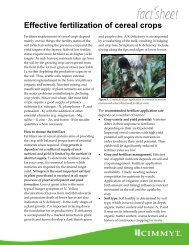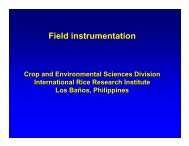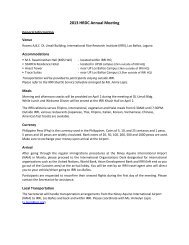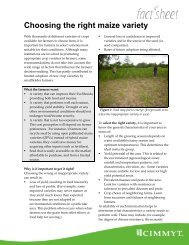Water management in irrigated rice - Rice Knowledge Bank ...
Water management in irrigated rice - Rice Knowledge Bank ...
Water management in irrigated rice - Rice Knowledge Bank ...
- No tags were found...
You also want an ePaper? Increase the reach of your titles
YUMPU automatically turns print PDFs into web optimized ePapers that Google loves.
<strong>in</strong>g that time was some 940 mm, of which 110mm was used for soak<strong>in</strong>g, 225 mm disappearedas surface runoff, 445 mm was lost by seepageand percolation, and 160 mm was lost by evaporation.In UPRIIS, farmers raise seedl<strong>in</strong>gs <strong>in</strong> part oftheir ma<strong>in</strong> field. Because of a lack of tertiary fieldchannels, the whole ma<strong>in</strong> field is soaked when theseedbed is prepared and rema<strong>in</strong>s flooded dur<strong>in</strong>gthe entire duration of the seedbed. In systems suchas UPRIIS, the turnaround time can be m<strong>in</strong>imizedby the <strong>in</strong>stallation of field channels, the adoptionof common seedbeds, or the adoption of direct wetor dry seed<strong>in</strong>g. With field channels, water can bedelivered to the <strong>in</strong>dividual seedbeds separately andthe ma<strong>in</strong> field does not need to be flooded. Commonseedbeds, either communal or privately managed,can be located strategically close to irrigation canalsand be <strong>irrigated</strong> as one block.With direct seed<strong>in</strong>g, the crop starts grow<strong>in</strong>gand us<strong>in</strong>g water from the moment of establishmentonward. Direct dry seed<strong>in</strong>g can also <strong>in</strong>creasethe effective use of ra<strong>in</strong>fall and reduce irrigationneeds as shown for the MUDA irrigation scheme<strong>in</strong> Malaysia (Cabangon et al 2002). However, dryseed<strong>in</strong>g with subsequent flood<strong>in</strong>g is possible only<strong>in</strong> heavy (clayey) soils with low permeability andpoor <strong>in</strong>ternal dra<strong>in</strong>age. A major driv<strong>in</strong>g force forthe adoption of direct seed<strong>in</strong>g <strong>in</strong> Asia is scarcityof labor s<strong>in</strong>ce direct seed<strong>in</strong>g does not use labor fortransplant<strong>in</strong>g and can be a mechanized operation.3.3 Crop growth period3.3.1 Saturated soil cultureIn saturated soil culture (SSC), the soil is kept asclose to saturation as possible, thereby reduc<strong>in</strong>gthe hydraulic head of the ponded water, which decreasesthe seepage and percolation flows. SSC <strong>in</strong>practice means that a shallow irrigation is given toobta<strong>in</strong> about 1 cm of ponded water depth a day orso after the disappearance of ponded water. Tabbalet al (2002) reported water sav<strong>in</strong>gs under SSC <strong>in</strong>transplanted and direct wet-seeded <strong>rice</strong> <strong>in</strong> puddledsoil, and <strong>in</strong> direct dry-seeded <strong>rice</strong> <strong>in</strong> nonpuddled soil(Table 3.1). Analyz<strong>in</strong>g a data set of 31 publishedfield experiments with an SSC treatment, Boumanand Tuong (2001) found that water <strong>in</strong>put decreasedon average by 23% (range: 5% to 50%) from thecont<strong>in</strong>uously flooded check, with a nonsignificantyield reduction of 6% on average. Thompson (1999)found that SSC <strong>in</strong> southern New South Wales,Australia, reduced both irrigation water <strong>in</strong>put andyield by a bit more than 10%.Raised beds can be an effective way to keepthe soil around saturation. <strong>Rice</strong> plants are grown onbeds and the water <strong>in</strong> the furrows is kept close to thesurface of the beds. In Australia, Borell et al (1997)experimented with raised beds that were 120 cmwide and separated by furrows of 30-cm width and15-cm depth to facilitate SSC practices. Comparedto flooded <strong>rice</strong>, water sav<strong>in</strong>gs were 34% and yieldlosses 16−34%. More <strong>in</strong>formation on raised bedsis found <strong>in</strong> Chapter 3.4.1.Practical implementationAlthough conceptually sound, SSC will be difficult toimplement practically s<strong>in</strong>ce it requires frequent (dailyor once every two days) applications of small amountsof irrigation water to just keep a stand<strong>in</strong>g water depthof 1 cm on flat land, or to keep furrows filled just to thetop <strong>in</strong> raised beds.3.3.2 Alternate wett<strong>in</strong>g and dry<strong>in</strong>gIn alternate wett<strong>in</strong>g and dry<strong>in</strong>g (AWD), irrigationwater is applied to obta<strong>in</strong> flooded conditions after acerta<strong>in</strong> number of days have passed after the disappearanceof ponded water. The number of days ofnonflooded soil <strong>in</strong> AWD before irrigation is appliedcan vary from 1 day to more than 10 days. ThoughTable 3.1a. Yield, water <strong>in</strong>put, and water productivity with respect to total water <strong>in</strong>put (WP IR) <strong>in</strong> transplanted and wet-seeded<strong>rice</strong> under cont<strong>in</strong>uous flood<strong>in</strong>g and SSC, Muñoz, 1991 dry season. Data from Tabbal et al (2002).TreatmentTransplantedWet-seededYield <strong>Water</strong> <strong>in</strong>put WP IRYield <strong>Water</strong> WP IR(t ha −1 ) (mm) (g gra<strong>in</strong> kg −1 water) (t ha −1 ) <strong>in</strong>put (mm) (g gra<strong>in</strong> kg −1 water)Flooded 7.4 694 1.06 7.6 631 1.20SSC 6.7 373 1.81 7.3 324 2.2719





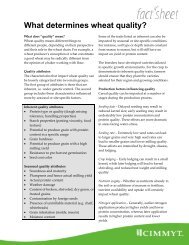

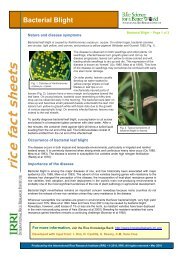

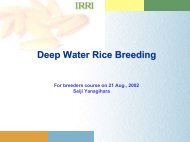
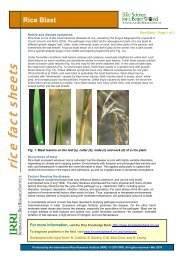
![International Standards' Organization â Rice Specification [ISO 7301]](https://img.yumpu.com/36696862/1/190x245/international-standards-organization-a-rice-specification-iso-7301.jpg?quality=85)

